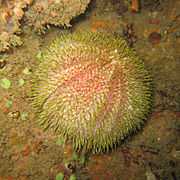Echinacea (animal)
| Echinacea Temporal range: Lower Jurassic–recent | |
|---|---|
 | |
| Echinus melo | |
| Scientific classification | |
| Kingdom: | Animalia |
| Phylum: | Echinodermata |
| Class: | Echinoidea |
| Superorder: | Echinacea |
| Orders | |
|
(See Text) | |
The Echinacea are a superorder of sea urchins. They are distinguished by the presence of a rigid test, with ten buccal plates around the mouth, and solid spines. Unlike some other sea urchins, they also possess gills. The group is a large one, with species found worldwide.
Echinacea are part of Animalia (Kingdom), Echinodermata (Phylum), Echinozoa (Subphylum), Echinoidea (Class), Euechinoidea (Subclass), Carinacea (Infraclass).
Child taxa
According to World Register of Marine Species:[1]
- Order Arbacioida (Gregory, 1900)
- Order Camarodonta (Jackson, 1912)
- Order Stomopneustoida (Kroh & Smith, 2010)
- Order Echinidea (Kroh & Smith, 2010)
- Order Temnopleuroida (Kroh & Smith, 2010)
- Family Glyphopneustidae (Smith & Wright, 1993)
- Family Pedinopsids (Kroh & Smith, 2010)
References
- ↑ "Echinacea WoRMS taxon details". World Register of Marine Species. Retrieved 29 July 2014.
- Barnes, Robert D. (1982). Invertebrate Zoology. Philadelphia, PA: Holt-Saunders International. p. 980. ISBN 0-03-056747-5.
- Kroh, A.; Smith, A.B. (2010). "The phylogeny and classification of post-Palaeozoic echinoids". Journal of Systematic Palaeontology 8 (2): 147–212. doi:10.1080/14772011003603556.
_in_Croatia.jpg)

